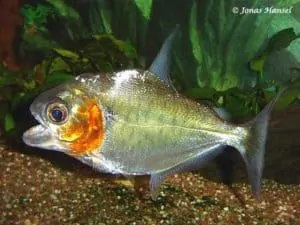Krobia xinguensis
Krobia xinguensis was officially described in 2012 by Sven Kullander. Before this time, the species was already known under the temporary names Krobia sp. Xingu or Aequidens sp. cf. guianensis. The species name xinguensis is derived from the origin of this species, Rio Xingu. This species has been available for the aquarium hobby since 1999.
The genus Krobia has only four species. Krobia xinguensis can be distinguished from the other species by the slightly deeper caudal peduncle and the dark lateral band that reaches the end of the dorsal fin compared to Krobia itanyi where that band ends much earlier. There are two distinct curved stripes between the eyes that are vague in Krobia itanyi and completely absent in Krobia guianensis. Krobia xinguensis also has two brown spots on its lower jaw, just below its lower lip, which are absent from the others.
Description
The ground color of Krobia xinguensis is whitish with a greenish, bluish, or greyish color on top, depending on the mood of the fish. A dark horizontal line runs across the sidelines. Seven vertical stripes also run along the flank, which sometimes almost disappear or get very dark.
The difference between the sexes is very difficult to see in Krobia xinguensis. The soft parts of the dorsal, anal, and pectoral fins are somewhat shorter in females than in males. The red on the cheeks is less bright in color, just like the blue/green color on the flank. The females also remain somewhat smaller than the males. An adult male can reach a total length of about 12 centimeters in the aquarium, and the female about 10 centimeters. In the aquarium, they can sometimes grow a little bigger.
Character
Besides the beautiful appearance of this species, it is notable for its peace-loving nature. Krobia xinguensis usually leaves other species alone, only small fish can sometimes be seen as food. Therefore keep them together with fish from four centimeters.
Biotope
The distribution area of Krobia xinguensis is limited to the Rio Xingu basin. They do occur frequently in this area. The water is soft and slightly acidic. Usually, they inhabit slow-flowing clear water with a lot of vegetation. As a result, many invertebrates can be found.
Diet
Not much official material can be found on the diet of Krobia xinguensis. However, they occur in parts with many aquatic plants and invertebrates. The diet of the fish in this part consists largely of insects, larvae, etc. This will not be much different for Krobia xinguensis.
In the aquarium, you can therefore feed them with a mixture of foods. Think of flakes, granulate, vegetables, frozen or live food. They are not fussy but feed them a variety to keep them healthy, as is the case with most fish species.
The Aquarium
This peaceful cichlid doesn’t need a lot of space. A pair of Krobia xinguensis can already be kept in a fairly small aquarium of 80 centimeters in length. There is not much room left for other fish species or congeners. If you want to keep a group, the aquarium will have to be a bit larger, from about 120 centimeters in length.
Decorate the aquarium with (filter) sand on the bottom. Provide plenty of plants for them to hide in and look for something edible. Place some wood and flat stones here and there.
The water may have a temperature of about 24 to 28 degrees Celsius with a pH of 5.0 to 7.5. Krobia xinguensis is not very sensitive to water values, but it goes without saying that it must be clean and stable.
Breeding Krobia xinguensis
This species is fairly easy to breed. Krobia xinguensis is an open substrate breeder. They prefer to lay their eggs on a flat stone. As soon as the male notices that the female is ready to spawn, he shows her his flank and flares his fins. His colors become even brighter than usual. He tries to get the female in the right mood with vibrating movements. When the female gets in the right mood, the stripes on her flank become more intense. Together they brush the place where the eggs are deposited. In doing so, they create a territory where other fish are chased away.
The female lays about 200 to 500 eggs, which are fertilized by the male. The pair fans and guards the eggs together. The eggs hatch about 2.5 to 4 days later, depending on the temperature and composition of the water. The young Krobia xinguensis are now moved to a shallow pit in the sand. From time to time, they move to a new pit until the fry are able to swim five to seven days after hatching. The flock of young Krobia xinguensis is guarded by both parents.
Conclusion
Krobia xinguensis is a relatively new species in the hobby. Because of its beautiful colors and peace-loving character, it is a real asset to the hobby! It is a species that we will probably encounter much more often in the aquarium.
Video
Author
John de Lange
Copyright images
References
Krobia xinguensis, a new species of cichlid fish from the Xingu River drainage in Brazil
Cichlidae.com
Fishbase.org








Reviews
There are no reviews yet.